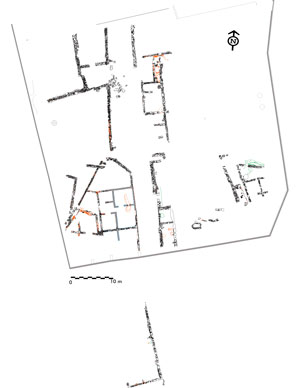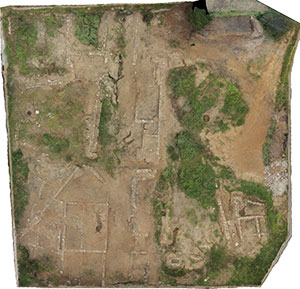 In broad terms, this sector divides into terraces at two
different levels. The archaeology of the lower terrace has
been known since the end of the 19th c., with the discovery
of the Iberian necropolis of Can Rodon, the continuation of
which to the north has always been supposed. Until 2006, no
archeological investigations of the upper terrace were
possible, but during the survey carried out in 2006 and
2010, 2,500 m2 of archaeological remains were discovered,
confirming that the structures on the lower terrace
continued onto the upper terrace.
In broad terms, this sector divides into terraces at two
different levels. The archaeology of the lower terrace has
been known since the end of the 19th c., with the discovery
of the Iberian necropolis of Can Rodon, the continuation of
which to the north has always been supposed. Until 2006, no
archeological investigations of the upper terrace were
possible, but during the survey carried out in 2006 and
2010, 2,500 m2 of archaeological remains were discovered,
confirming that the structures on the lower terrace
continued onto the upper terrace.
As a result of these excavations, it can be concluded that the terraces are not natural features. The original terrain was just a single surface, with a rise in level toward the east that was reduced during the late Republican period, so that the buildings might fit more conveniently into the landscape.
The archaeological remains found in 2006 show a complex pattern of occupation over time. The first structures are a group of three storage pits at the highest point in the east, which date to the 5th c. B.C.E. Again in the east, where the Iberian necropolis is situated, important sedimentary deposits were discovered, which contain materials of the 4th – 3rd c. B.C.E., mixed with some later materials. At the north end of the site, a series of alluvial deposits two meters thick lay over earlier strata, on top of which a production center for Dressel 2-3 amphorae was discovered, which was in use during the 1st c. B.C.E. and possibly at the beginning of the 1st century C.E.
However, the most important archaeological remains are the structures of the late Republican period, which occupy more than half of the western part of the site and a great part of the south-west quadrant forming an insula delimited by streets. The main street, more than 5 meters wide, is oriented north-south and is thought to be more than fifty meters long. The eastern side of the street appears to be occupied by a number of workshops, some dedicated to metallurgy, while the western side hosts at least two households of significant dimensions, which is not yet well known because little work has yet to be done on it. That said, an important number of amphorae of Italic orign were excavated and recovered during the excavations tasks that took place in 2006. These structures all date to the same period as the area to the east of the Cabrera de Mar stream and use similar construction techniques.
The structures of the south-east quadrant are later, dating to around the time of abandonment. The architecture is less careful and more uneven. This set of rooms, which has been damaged by modern leveling of the site at the southern and eastern edges, seems to have been a lead-working area seeing as much scrap intended for melting was recovered during excavations.
The Can Rodon de l’Hort sector excavated thus far seems to continue in every direction except towards the east, where modern construction has destroyed the archaeological remains. We know that the very poorly preserved constructions that have been recognized to the north in the l’Hostal sector, which are very close, may be a continuation of the Can Rodon de l’Hort site. Even more important remains appear to be present on the Mas Català site, only some thirty meters away from the structures of the southeast quadrant of Can Rodon de l’Hort, and separated from them by the destruction during the modern period.
The content displayed on this page reproduces, with permission of the author and the journal, fragments of the following article: Sinner, A. G. “Cultural contacts and identity construction: a colonial context in NE Spain (2nd – early 1st c. B.C.),” Journal of Roman Archaeology 28 (2015) 7-37.
References:
López, A. and Martín, A. "Un nuevo centro productor de ánforas tarraconenses, paredes finas y otras cerámicas en Can Rodon de l'Hort (Cabrera de Mar, Barcelona)," REI CRETARIÆ ROMANÆ FAVTORVM (Vol. 41, 2010) 1-14.
Martín, A. and García, J. “La vall de Cabrera de Mar. Focus inicials de la producció vitivinícola de la Laietània,” Pottery workshops and agricultural productions.Studies on the rural world in the Roman period 2 (Gerona 2007) 70.
